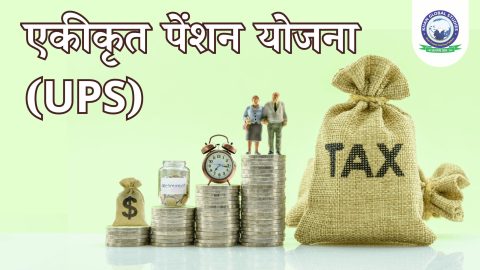The Unified Pension Scheme (UPS) marks a significant change in the retirement landscape for central government employees, which is set to begin on April 1, 2025. The scheme is designed to provide a stable pension that depends on the period of service and the last drawn salary of the employees. Under the UPS, employees can switch from the National Pension System (NPS) to avail of this consolidated pension scheme. The scheme guarantees a minimum pension of ₹10,000 per month after completing 10 years of service. In addition, it includes provisions for lump sum payment at the time of retirement and family pension, which ensure financial security for the employee’s family. Maharashtra is the first state to implement the Unified Pension Scheme (UPS).
What is the Unified Pension Scheme?
The Unified Pension Scheme is a government-backed initiative that aims to consolidate various pension schemes under one umbrella. The primary goal is to simplify the retirement process, making it easier for individuals to manage their retirement funds. This plan is designed to provide retirees with a steady income stream, ensuring that they maintain a comfortable standard of living in their retirement years.
Key Benefits of Unified Pension Scheme
- Streamlined Management of Retirement Funds: The most significant benefit of an integrated pension plan is its ability to consolidate multiple pension accounts into one. This feature simplifies the management of retirement savings, allowing individuals to track and optimize their investments more efficiently. With a single account, retirees can avoid the complexities of managing multiple accounts, each of which has different rules and regulations.
- Enhanced Financial Security: The integrated pension plan provides enhanced financial security by ensuring that retirees receive a guaranteed income throughout their lives. This feature is especially important in today’s economic climate, where market fluctuations can significantly impact retirement savings. By providing a steady income stream, this plan helps retirees maintain their standard of living without the fear of running out of their savings.
- Tax Benefits: Another major benefit of an integrated pension plan is that it offers tax benefits. Contributions to the plan are typically tax-deductible, reducing the overall tax burden on participants. Additionally, income generated from the pension fund may be subject to favourable tax treatment, further increasing the financial benefits of the plan.
- Flexibility in Contributions: The integrated pension plan is designed to be flexible, allowing individuals to adjust their contributions based on their financial situation. Whether you are a young professional just starting your career or an experienced employee nearing retirement, this plan offers the flexibility to customize your contributions to meet your retirement goals.
Eligibility Criteria for Integrated Pension Plan
Individuals must meet specific eligibility criteria to participate in an integrated pension plan. These criteria may vary depending on the country or region, but generally include the following:
- Age Requirements: Most integrated pension plans have a minimum age requirement for participation, which typically begins at age 18. There may also be a maximum age limit for entry into the plan.
- Employment Status: Plans are often open to both employed and self-employed individuals. However, specific employment sectors may have their eligibility requirements.
- Contribution Requirements: Participants must make regular contributions to the plan to remain eligible. These contributions may vary based on income level and other factors.
How to Enroll in the Unified Pension Scheme?
Enrolling in an Integrated Pension Plan is a straightforward process. You need to follow the following steps:
- Research and Compare Plans: Before enrolling, it is essential to research and compare the various integrated pension plans available in your area. Look for plans that offer the best benefits, lowest fees, and most favourable terms for your specific situation.
- Consult a Financial Advisor: Given the complexities of retirement planning, consulting a financial advisor is highly recommended. A professional can help you understand the finer details of the plan, ensuring that you make an informed decision that aligns with your long-term financial goals.
- Complete the Application Process: Once you have chosen a plan, the next step is to complete the application process. This usually involves providing personal information, employment details, and financial data. Some plans may require a medical examination or additional documentation.
- Start Contributing: After successfully enrolling in the plan, you need to start making regular contributions. It is very important to create a contribution plan that is in sync with your retirement goals. Many plans offer automatic deduction options, making it easier to keep your contributions on track.
Choosing between UPS and NPS
Central government employees now have the option to choose between the Unified Pension Scheme (UPS) and the National Pension System (NPS). Additionally, existing NPS subscribers have the freedom to switch to UPS. State governments can also choose to implement this scheme for their employees in the future. Notably, Maharashtra is the first state to implement the Unified Pension Scheme (UPS).
Understanding the Unified Pension Scheme (UPS)
The Unified Pension Scheme (UPS) is a groundbreaking initiative by the government, aimed at providing a stable pension to government employees based on their service period and last drawn salary. The scheme ensures that at the time of retirement, employees receive a lump sum payment, consisting of 10% of their salary and dearness allowance (DA) for every six months of service.
Union Information and Broadcasting Minister Ashwini Vaishnaw highlighted that the “five pillars” of UPS will come into effect from April next year. He further explained that those who have completed 10 years of service will get a minimum pension of Rs 10,000, while the family pension for the spouse of a deceased government employee will be 60% of the employee’s pension. The minister clarified that after 30 years of service, retirees will get a lump sum payment equivalent to about six months’ salary in addition to gratuity.
What is the National Pension System (NPS)?
The central government launched the contribution-based pension system National Pension System (NPS) on January 1, 2004. Under the scheme, government employees contribute a part of their monthly salary towards their pension, with the employer also making an equal contribution. These funds are invested in specified investment schemes through pension fund managers.
Maximum Benefits under the Unified Pension Scheme
To get the most out of the Unified Pension Scheme, consider the following strategies:
- Even small contributions made early in your career can add up over time, thanks to compound interest.
- Review and Adjust Contributions Regularly: As your financial situation changes, it is important to review and adjust your contributions regularly. Whether you have received a raise, changed jobs, or experienced a significant event, updating your contribution levels can help you meet your retirement goals.
- Take Advantage of Employer Contributions: If your employer makes a matching contribution to the Unified Pension Scheme, take full advantage of this benefit. Employer contributions are essentially free money that can boost your retirement savings substantially.
- Diversify your Investment Portfolio: While the Unified Pension Plan provides a solid foundation for retirement savings, it is wise to diversify your investment portfolio. Consider investing in other retirement accounts, such as an IRA or 401(k), to minimize risk and increase potential returns.
Conclusion
Integrated pension planning is a powerful tool for securing your financial future. By understanding its benefits, eligibility requirements, and strategies for maximizing your contributions, you can create a strong retirement plan that ensures a comfortable and worry-free retirement. Start planning today to take full advantage of the opportunities presented by integrated pension planning.





